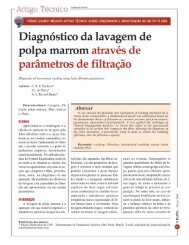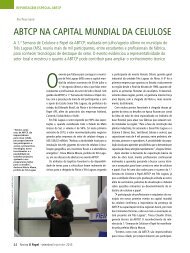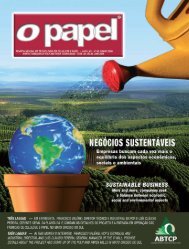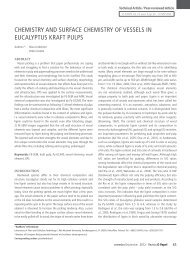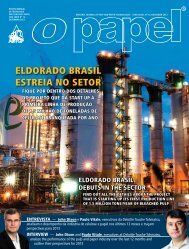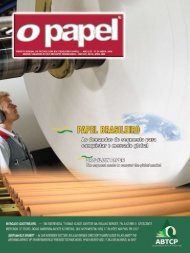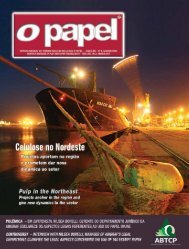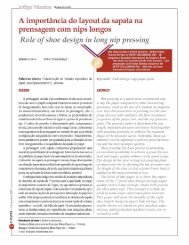Create successful ePaper yourself
Turn your PDF publications into a flip-book with our unique Google optimized e-Paper software.
Technical Article / Peer-reviewed Article<br />
O PAPEL vol. 73, num. 7, pp. 57 - 65 JUL 2012<br />
100 µm 100 µm<br />
Figure 8. Pulp in the Na + -form refined at 125 kWh/t. Fines had been<br />
removed. WRV was 2.41 when the fines were present in the pulp sample<br />
Figure 7. The apparent yield stress as a function of pulp consistency for<br />
pulps refined in different ionic forms and at different energy inputs<br />
The apparent yield stress was dependent on pulp consistency as<br />
shown in Figure 7, but was independent of ionic form of the fibres<br />
or of the refining degree.<br />
External fibrillation<br />
The fibrillation of the pulp samples was evaluated by several<br />
methods: image analysis to determine the amount of fibrils<br />
on the surface according to Kurhila (2005), light scattering<br />
(Karlsson, Pettersson, 1982; Pettersson, 2010) and traditional<br />
phase contrast microscopy to study the degree of external<br />
fibrillation on the fibre surfaces.<br />
The degree of external fibrillation was determined by image<br />
analysis and MMS for a limited number of pulp samples,<br />
Table 2. The results using the image analysis method showed<br />
that at a given specific refining energy input (50 kWh/t and<br />
125 kWh/t) the pulp in the H + -form had the highest degree of<br />
external fibrillation. Despite the much higher WRV and higher<br />
ºSR, the pulp in Na + -form had a lower degree of external<br />
fibrillation than the pulp in H + -form.<br />
Table 2 includes the crill KFP values based on the MMS light<br />
scattering technique. A value of 171% means that 71% of the total<br />
surface is made out of crill, with an uncertainty of ±0.5%. These<br />
100 µm 100 µm<br />
Figure 9. Pulp in the H + -form refined at 125 kWh/t. Fines had been<br />
removed. WRV was 1.79 when the fines were present in the pulp sample<br />
100 µm<br />
Figure 10. Pulp in the Ca 2+ -form refined at 125 kWh/t. Fines had been<br />
removed. WRV was 1.77 when the fines were present in the pulp sample<br />
results clearly contradict the results obtained by image analyses.<br />
The external fibrillation was also examined using phase<br />
contrast in a microscopy and distinct differences between the<br />
samples were observed. The microscopic examination showed<br />
that the Na + -pulp fibres differed from fibres refined in the H + - and<br />
the Ca 2+ -forms, Figure 8-10.<br />
100 µm<br />
Table 2. Degree of external fibrillation of the pulp samples. The refining energy input (SRE), the °SR number and the WRV are also given<br />
Sample SRE ºSR WRV External fibrillation, % Crill, KFP<br />
Ca50 50 15 1,57 0.7 -<br />
Ca100 100<br />
21<br />
1,70 - 170,5<br />
Na50 50 20 1.82 1 160.4<br />
Na100 100 45<br />
2,19<br />
- 177<br />
Na125 125 61<br />
2,41<br />
3.5 -<br />
H50 50 17 1.58 1.5 157.2<br />
H100 100 25<br />
1,73<br />
- 171.6<br />
H125 125 27 1,79 4.2 -<br />
julho/July 2012 - <strong>Revista</strong> O <strong>Papel</strong><br />
61



